Research of Friction Stir Welding (FSW) and Electron Beam Welding (EBW) Process for 6082-T6 Aluminum Alloy
Abstract
1. Introduction
2. Materials and Methods
3. Results and Discussion
3.1. Microstructure
3.2. Mechanical Properties
4. Conclusions
Author Contributions
Funding
Institutional Review Board Statement
Informed Consent Statement
Data Availability Statement
Conflicts of Interest
References
- Miller, W.S.; Zhuang, L.; Bottema, J.; Wittebrood, A.J.; De Smet, P.; Haszler, A.; Vieregge, A. Recent development in aluminium alloys for the automotive industry. Mater. Sci. Eng. A 2000, 280, 37–49. [Google Scholar] [CrossRef]
- Włoch, G.; Skrzekut, T.; Sobota, J.; Woźnicki, A.; Cisoń, J. The Structure and Mechanical Properties of Plastically Consolidated Al-Ni Alloy. Key Eng. Mater. 2016, 682, 245–251. [Google Scholar] [CrossRef]
- Noga, P.; Piotrowicz, A.; Skrzekut, T.; Zwoliński, A.; Strzępek, P. Effect of Various Forms of Aluminum 6082 on the Mechanical Properties, Microstructure and Surface Modification of the Profile after Extrusion Process. Materials 2021, 14, 5066. [Google Scholar] [CrossRef] [PubMed]
- Dashwood, R.J.; Grimes, R. Structural Materials: Aluminum and Its Alloys—Properties. In Encyclopedia of Aerospace Engineering; Mueller, E., Ed.; John Wiley & Sons, Ltd.: New York, NY, USA, 2010. [Google Scholar]
- Verhaeghe, G.; Hilton, P. Laser Welding of Low-Porosity Aerospace Aluminum Alloy. In Proceedings of the 34th International MATADOR Conference, Manchester, UK, 7–9 July 2004; pp. 241–246. [Google Scholar] [CrossRef]
- Kumar, N.; Goel, S.; Jayaganthan, R.; Owolabi, G. The influence of metallurgical factors on low cycle fatigue behavior of ultra-fine grained 6082 Al alloy. Int. J. Fatigue 2018, 110, 130–143. [Google Scholar] [CrossRef]
- Zhao, H.; White, D.; DebRoy, T. Current issues and problems in laser welding of automotive aluminium alloys. Int. Mater. Rev. 1999, 44, 238–266. [Google Scholar] [CrossRef]
- Tiwari, S.K.; Kumar Shukla, D.; Chandra, R. Friction Stir Welding of Aluminum Alloys: A Review. Int. J. Mech. Aerosp. Ind. Mechatron. Eng. 2013, 7, 1326–1331. [Google Scholar]
- Mishra, R.S.; Ma, Z.Y. Friction stir welding and processing. Mater. Sci. Eng. R Rep. 2005, 50, 1–78. [Google Scholar] [CrossRef]
- Lacki, P.; Kucharczyk, Z.; Śliwa, R.E.; Gałaczyński, T. Influence of selected parameters of friction stir welding process on the temperature field. Rudy I Met. Nieżelazne 2012, 57, 524–532. [Google Scholar]
- Zhang, Y.N.; Cao, X.; Larose, S.; Wanjara, P. Review of tools for friction stir welding and processing. Can. Met. Q. 2012, 51, 250–261. [Google Scholar] [CrossRef]
- Verma, S.M.; Misra, J.P. A critical review of friction stir welding process. In DAAAM International Scientific Book; DAAAM International: Vienna, Austria, 2015; pp. 249–266. [Google Scholar] [CrossRef]
- Cho, J.-H.; Kim, W.J.; Gil Lee, C. Texture and microstructure evolution and mechanical properties during friction stir welding of extruded aluminum billets. Mater. Sci. Eng. A 2014, 597, 314–323. [Google Scholar] [CrossRef]
- Sahu, P.K.; Pal, S. Mechanical properties of dissimilar thickness aluminium alloy weld by single/double pass FSW. J. Mater. Process. Technol. 2017, 243, 442–455. [Google Scholar] [CrossRef]
- Gibson, B.T.; Lammlein, D.H.; Prater, T.J.; Longhurst, W.R.; Cox, C.D.; Ballun, M.C.; Dharmaraj, K.J.; Cook, G.E.; Strauss, A.M. Friction stir welding: Process, automation, and control. J. Manuf. Process. 2014, 16, 56–73. [Google Scholar] [CrossRef]
- Elangovan, K.; Balasubramanian, V.; Valliappan, M. Influences of tool pin profile and axial force on the formation of friction stir processing zone in AA6061 aluminium alloy. Int. J. Adv. Manuf. Technol. 2008, 38, 285–295. [Google Scholar] [CrossRef]
- Krasnowski, K.; Hamilton, C.; Dymek, S. Influence of the tool shape and weld configuration on microstructure and mechanical properties of the Al 6082 alloy FSW joints. Arch. Civ. Mech. Eng. 2015, 15, 133–141. [Google Scholar] [CrossRef]
- Bondarev, A.A.; Lobanov, L.M.; Pivtorak, V.A.; Prisyazhnyuk, V.I.; Krylov, V.G. Examination of the mechanical properties, structure and deformations of electron-beam welded joints in alloy 01420 [Al-Mg-Li]. Autom. Weld. 1975, 28, 11–13. [Google Scholar]
- Bowden, D.M.; Meschter, P.J. Electron-beam weld solidification structures and properties in Al 3Li X alloys. Scr. Met. 1984, 18, 963–968. [Google Scholar] [CrossRef]
- Sakamoto, Y.; Shibuta, C.; Sanuki, S.; Mae, T.; Notoya, H.; Arai, K. Mechanicalproperties and corrosion resistance of Al–Mg alloys with Cu added by electron beam welding. Mater. Trans. JIM 1999, 40, 556–563. [Google Scholar] [CrossRef]
- Çam, G.; Koçak, M. Microstructural and mechanical characterization of electron beam welded Al-alloy 7020. J. Mater. Sci. 2007, 42, 7154–7161. [Google Scholar] [CrossRef]
- Nagai, T.; Kasai, R.; Ueno, K.; Mochizuki, M.; Suga, T. Effects of Metal Types on Residual Stress in Electron-Beam Welding Joints with Sheet Metals. ISIJ Int. 2015, 55, 241–249. [Google Scholar] [CrossRef]
- Puydt, Q.; Flouriot, S.; Ringeval, S.; De Geuser, F.; Estevez, R.; Parry, G.; Deschamps, A. Relationship Between Microstructure, Strength, and Fracture in an Al-Zn-Mg Electron Beam Weld: Part II: Mechanical Characterization and Modeling. Met. Mater. Trans. A 2014, 45, 6141–6152. [Google Scholar] [CrossRef]
- Puydt, Q.; Flouriot, S.; Ringeval, S.; De Geuser, F.; Parry, G.; Deschamps, A. Relationship Between Microstructure, Strength, and Fracture in an Al-Zn-Mg Electron Beam Weld: Part I: Microstructure Characterization. Met. Mater. Trans. A 2014, 45, 6129–6140. [Google Scholar] [CrossRef]
- Ahmadi, M.; Pahlavani, M.; Rahmatabadi, D.; Marzbanrad, J.; Hashemi, R.; Afkar, A. An Exhaustive Evaluation of Fracture Toughness, Microstructure, and Mechanical Characteristics of Friction Stir Welded Al6061 Alloy and Parameter Model Fitting Using Response Surface Methodology. J. Mater. Eng. Perform. 2022, 31, 3418–3436. [Google Scholar] [CrossRef]
- Kumar, R.; Dilthey, U.; Dwivedi, D.K.; Sharma, S.P.; Ghosh, P.K. Welding of thin sheet of Al alloy (6082) by using Vario wire DC P-GMAW. Int. J. Adv. Manuf. Technol. 2009, 42, 102–117. [Google Scholar] [CrossRef]
- Sánchez-Amaya, J.; Delgado, T.; González-Rovira, L.; Botana, F. Laser welding of aluminium alloys 5083 and 6082 under conduction regime. Appl. Surf. Sci. 2009, 255, 9512–9521. [Google Scholar] [CrossRef]
- Walter, V.; Weidenmann, K.; Schulze, V. A Comparison of FSW, BHLW and TIG Joints for Al-Si-Mg Alloy (EN AW-6082 T6). Procedia CIRP 2014, 18, 120–125. [Google Scholar] [CrossRef]
- Pinto, L.A.; Quintino, L.; Miranda, R.M.; Carr, P. Laser Welding of Dissimilar Aluminium Alloys with Filler Materials. Weld. World 2010, 54, R333–R341. [Google Scholar] [CrossRef]
- Aminzadeh, A.; Parvizi, A.; Safdarian, R.; Rahmatabadi, D. Comparison between laser beam and gas tungsten arc tailored welded blanks via deep drawing. Proc. Inst. Mech. Eng. Part B 2021, 235, 673–688. [Google Scholar] [CrossRef]
- PN-EN 485-2+A1:2018-12; Aluminum and Aluminum Alloys—Sheets, Plates and Slabs—Part 2: Mechanical Properties. European Committee of Standardization: Brussels, Belgium, 2020.
- PN-EN ISO 4136:2022-12; Destructive Tests on Welds in Metallic Materials. Transverse Tensile Test. International Organization for Standardization: Geneva, Switzerland, 2022.
- Mrówka-Nowotnik, G.; Sieniawski, J.; Wierzbińska, M. Intermetallic phase particles in 6082 aluminium alloy. Arch. Mater. Sci. Eng. 2007, 28, 69–76. [Google Scholar]
- Wimmer, A.; Lee, J.; Schumacher, P. Phase Selection in 6082 Al-Mg-Si Alloys. BHM Berg-Und Hüttenmännische Monatshefte 2012, 157, 301–305. [Google Scholar] [CrossRef]
- Hidalgo-Manrique, P.; Cao, S.; Shercliff, H.; Hunt, R.; Robson, J. Microstructure and properties of aluminium alloy 6082 formed by the Hot Form Quench process. Mater. Sci. Eng. A 2021, 804, 140751. [Google Scholar] [CrossRef]
- Hua, L.; Yuan, P.-G.; Zhao, N.; Hu, Z.-L.; Ma, H.-J. Microstructure and mechanical properties of 6082 aluminum alloy processed by preaging and hot forging. Trans. Nonferrous Met. Soc. China 2022, 32, 790–800. [Google Scholar] [CrossRef]
- Donatus, U.; Thompson, G.; Zhou, X.; Wang, J.; Beamish, K. Flow patterns in friction stir welds of AA5083 and AA6082 alloys. Mater. Des. 2015, 83, 203–213. [Google Scholar] [CrossRef]
- Nami, H.; Adgi, H.; Sharifitabar, M.; Shamabadi, H. Microstructure and mechanical properties of friction stir welded Al/Mg2Si metal matrix cast composite. Mater. Des. 2011, 32, 976–983. [Google Scholar] [CrossRef]
- Salih, O.S.; Neate, N.; Ou, H.; Sun, W. Influence of process parameters on the microstructural evolution and mechanical characterisations of friction stir welded Al-Mg-Si alloy. J. Mater. Process. Technol. 2020, 275, 116366. [Google Scholar] [CrossRef]
- Baghdadi, A.H.; Rajabi, A.; Selamat, N.F.M.; Sajuri, Z.; Omar, M.Z. Effect of post-weld heat treatment on the mechanical behavior and dislocation density of friction stir welded Al6061. Mater. Sci. Eng. A 2019, 754, 728–734. [Google Scholar] [CrossRef]
- Çam, G.; Ventzke, V.; Dos Santos, J.F.; Koçak, M.; Jennequin, G.; Gonthier-Maurin, P. Characterisation of electron beam welded aluminium alloys. Sci. Technol. Weld. Join. 1999, 4, 317–323. [Google Scholar] [CrossRef]
- Kaisheva, D.; Anchev, A.; Dunchev, V.; Kotlarski, G.; Stoyanov, B.; Ormanova, M.; Valkov, S. Electron Beam Welding Cu and 6082T6 Aluminum Alloys with Circular Beam Oscillations. Crystals 2022, 12, 1757. [Google Scholar] [CrossRef]
- Ma, T.; den Ouden, G. Softening behaviour of Al–Zn–Mg alloys due to welding. Mater. Sci. Eng. A 1999, 266, 198–204. [Google Scholar] [CrossRef]
- Jandaghi, M.; Parvin, P.; Torkamany, P.P.; Sabbaghzadeh, J. Measurement of the composition change in Al5754 alloy during long pulsed Nd: YAG laser welding based on LIBS. J. Phys. D 2009, 42, 205301. [Google Scholar] [CrossRef]
- Pastor, M.; Zhao, H.; Martukanitz, R.; Debroy, T. Porosity, underfill and magnesium loss during continuous wave Nd:YAG laser welding of thin plates of aluminum alloys 5182 and 5754. Weld. J. 1999, 78, 207-s. [Google Scholar]
- Luo, Y. Modeling and analysis of vaporizing during vacuum electron beam welding on magnesium alloy. Appl. Math. Model. 2013, 37, 6177–6182. [Google Scholar] [CrossRef]
- Liu, Y.; Liu, H.; Chen, Z. Post-fire mechanical properties of aluminum alloy 6082-T6. Constr. Build. Mater. 2019, 196, 256–266. [Google Scholar] [CrossRef]
- Alexopoulos, N.D.; Examilioti, T.N.; Stergiou, V.; Kourkoulis, S.K. Tensile mechanical performance of electron-beam welded joints from aluminum alloy (Al-Mg-Si) 6156. Procedia Struct. Integr. 2016, 2, 3539–3545. [Google Scholar] [CrossRef]
- Svensson, L.E.; Karlsson, L.; Larsson, H.; Karlsson, B.; Fazzini, M.; Karlsson, J. Microstructure and mechanical properties of friction stir welded aluminium alloys with special reference to AA 5083 and AA 6082. Sci. Technol. Weld. Join. 2013, 5, 285–296. [Google Scholar] [CrossRef]
- PN-EN ISO 15614-2:2005; Specification and Qualification of Welding Procedures for Metallic Materials—Welding Procedure Test—Part 2: Arc Welding of Aluminium and Its Alloys. European Committee for Standardization (CEN): Brussels, Belgium, 2005.
- Adamowski, J.; Gambaro, C.; Lertora, E.; Ponte, M.; Szkodo, M. Analysis of FSW welds made of aluminium alloy AW6082-T6. Arch. Mater. Sci. Eng. 2007, 28, 453–460. [Google Scholar]
- Pietras, A.; Rams, B.; Węglowska, A. FSW of aluminium alloys series 6000. Arch. Mech. Technol. Autom. 2007, 27, 93–102. [Google Scholar]
- Maggiolini, E.; Tovo, R.; Susmel, L.; James, M.N.; Hattingh, D.G. Crack path and fracture analysis in FSW of small diameter 6082_T6 aluminium tubes under tension-torsion loading. Int. J. Fatigue 2016, 92, 478–487. [Google Scholar] [CrossRef]
- Beygi, R.; Mehrizi, M.Z.; Akhavan-Safar, A.; Mohammadi, S.A. Parametric Study on the Effect of FSW Parameters and the Tool Geometry on the Tensile Strength of AA2024–AA7075 Joints: Microstructure and Fracture. Lubricants 2023, 11, 59. [Google Scholar] [CrossRef]
- Beygi, R.; Marques, E.; da Silva, L.F.M. Computational Concepts in Simulation of Welding Processes; Springer: Cham, Switzerland, 2022. [Google Scholar] [CrossRef]
- Rao, C.R.; Srinivasulu, B. An Experimental Investigation on Mechanical Properties of Friction Stir Welding of Copper by using EN19 and EN31 Circular and Taper Thread Profile Tool. IJETSR 2017, 4, 474–479. [Google Scholar]
- Noga, P.; Węglowski, M.; Ziemierska-Nowak, P.; Richert, M.; Dworak, J.; Rykała, J. Influence of welding techniques on microstructure and hardness of steel joints used in automotive air conditioners. Met. Foundry Eng. 2017, 43, 281. [Google Scholar] [CrossRef]
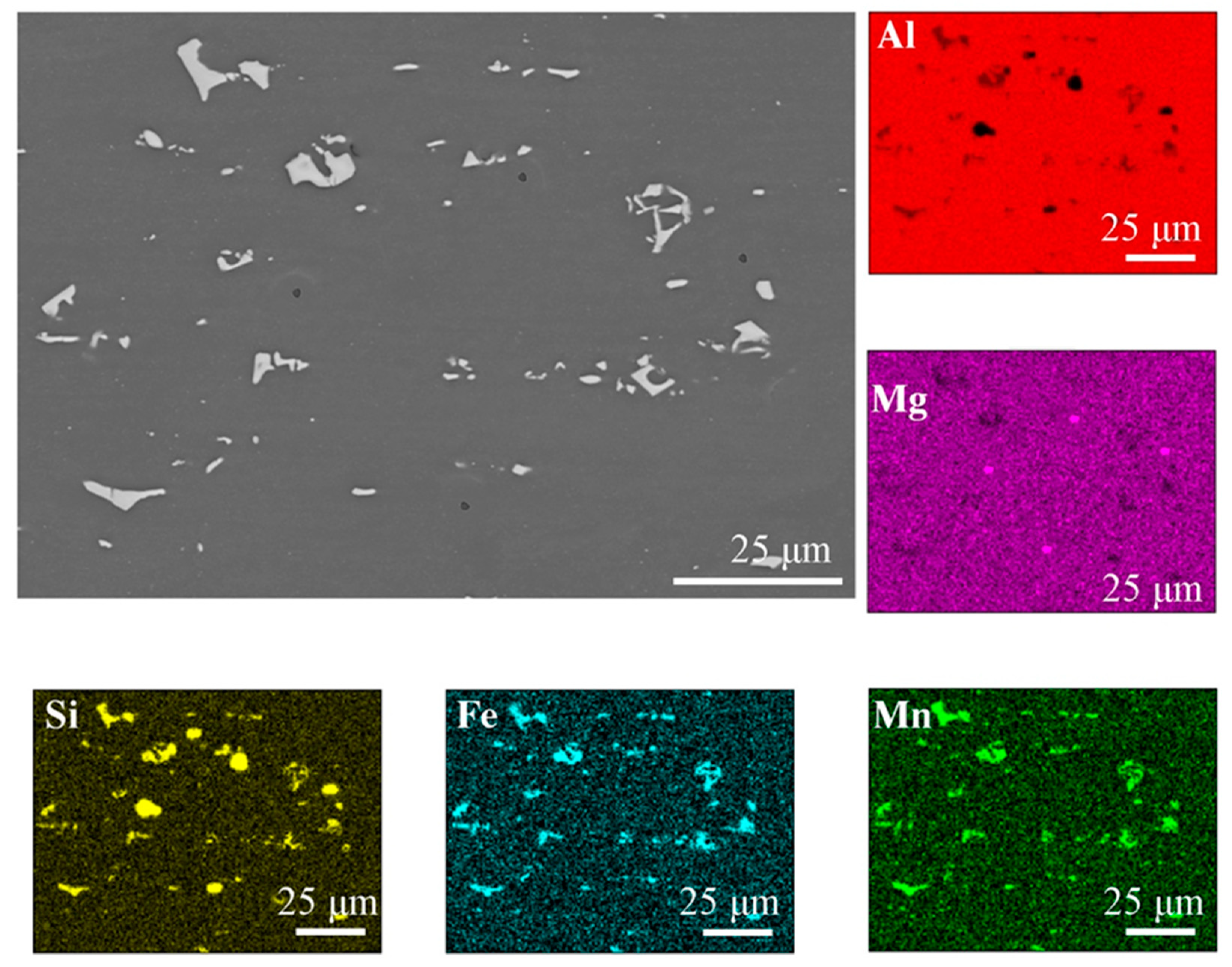
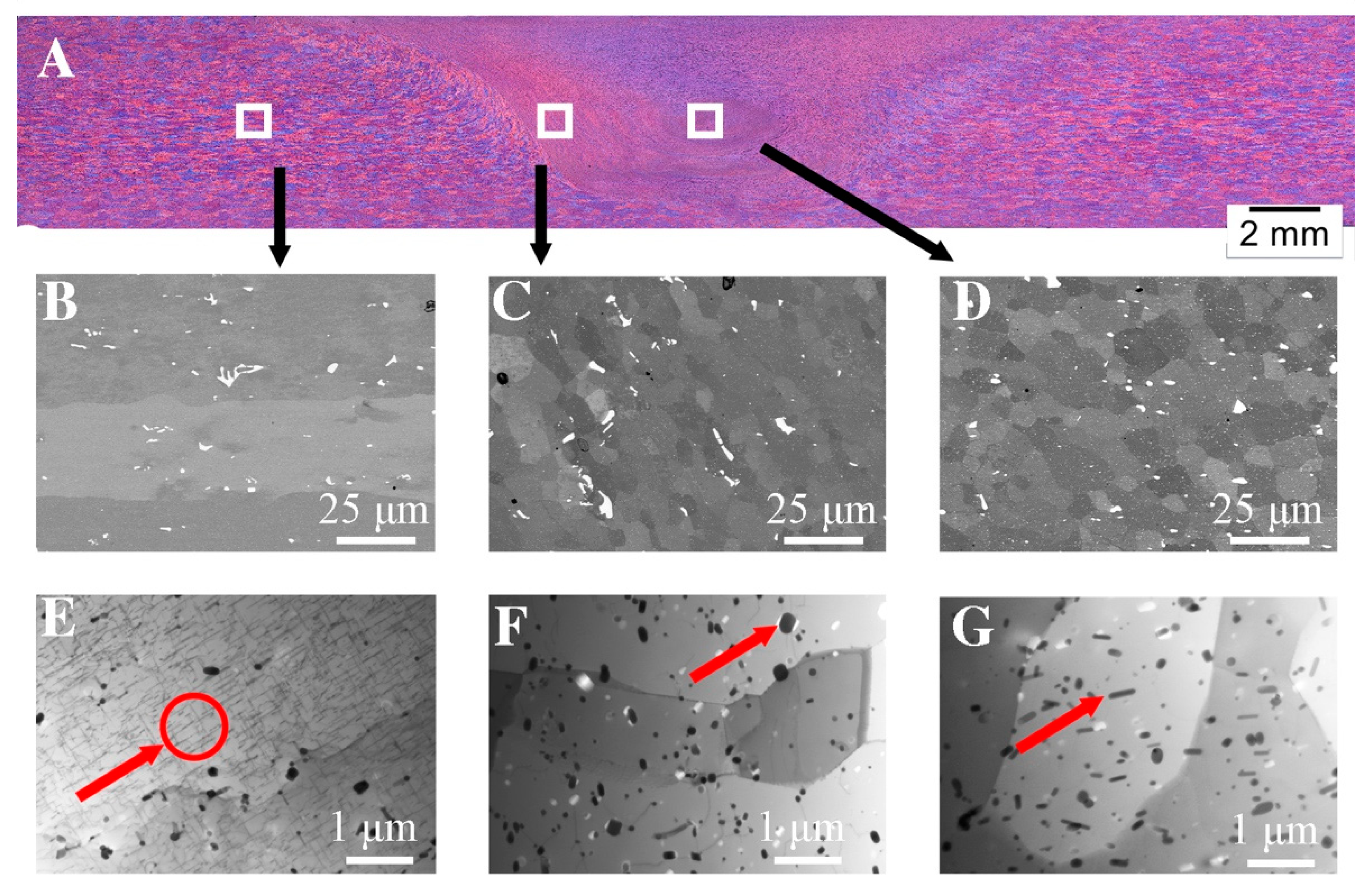
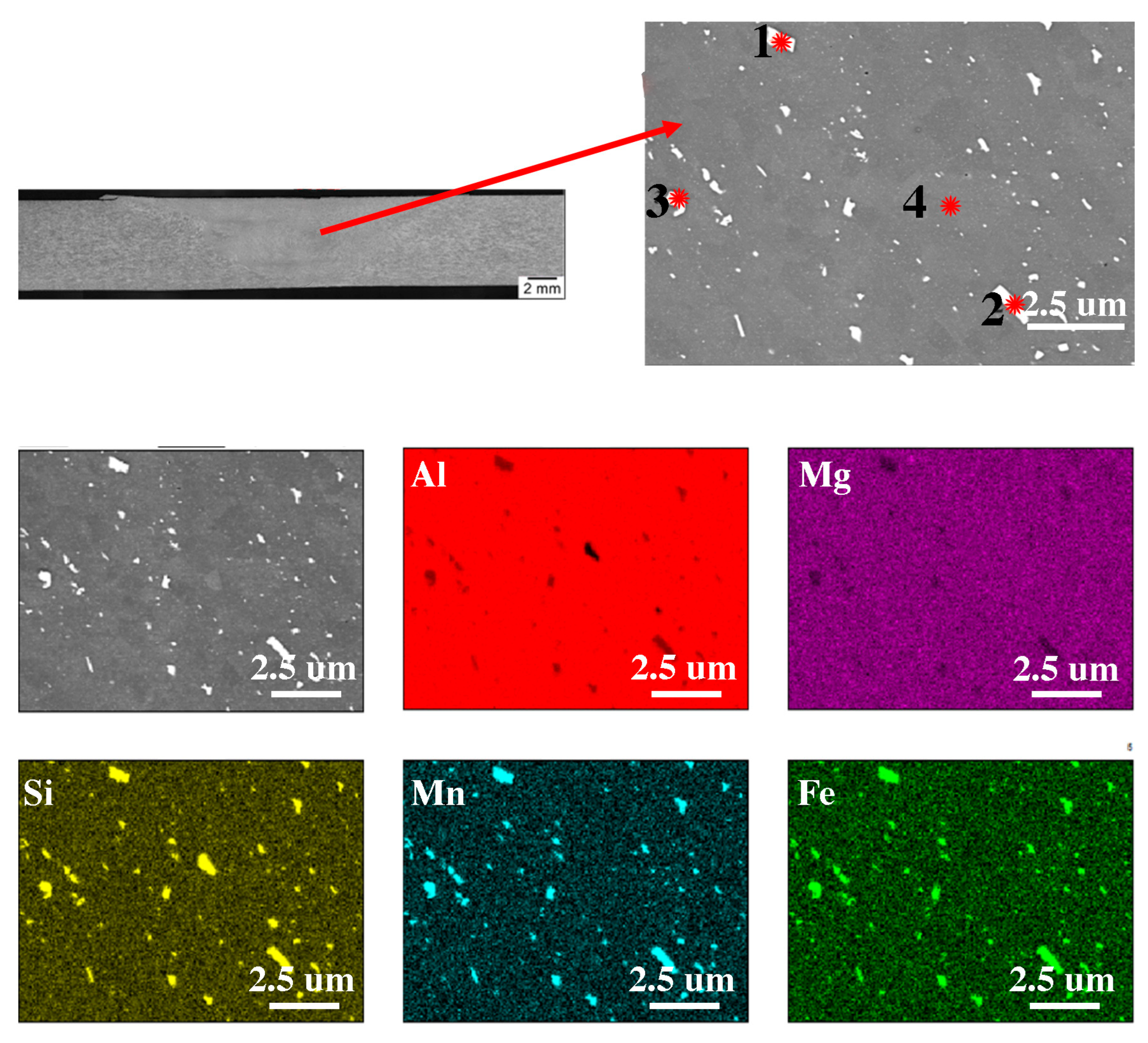
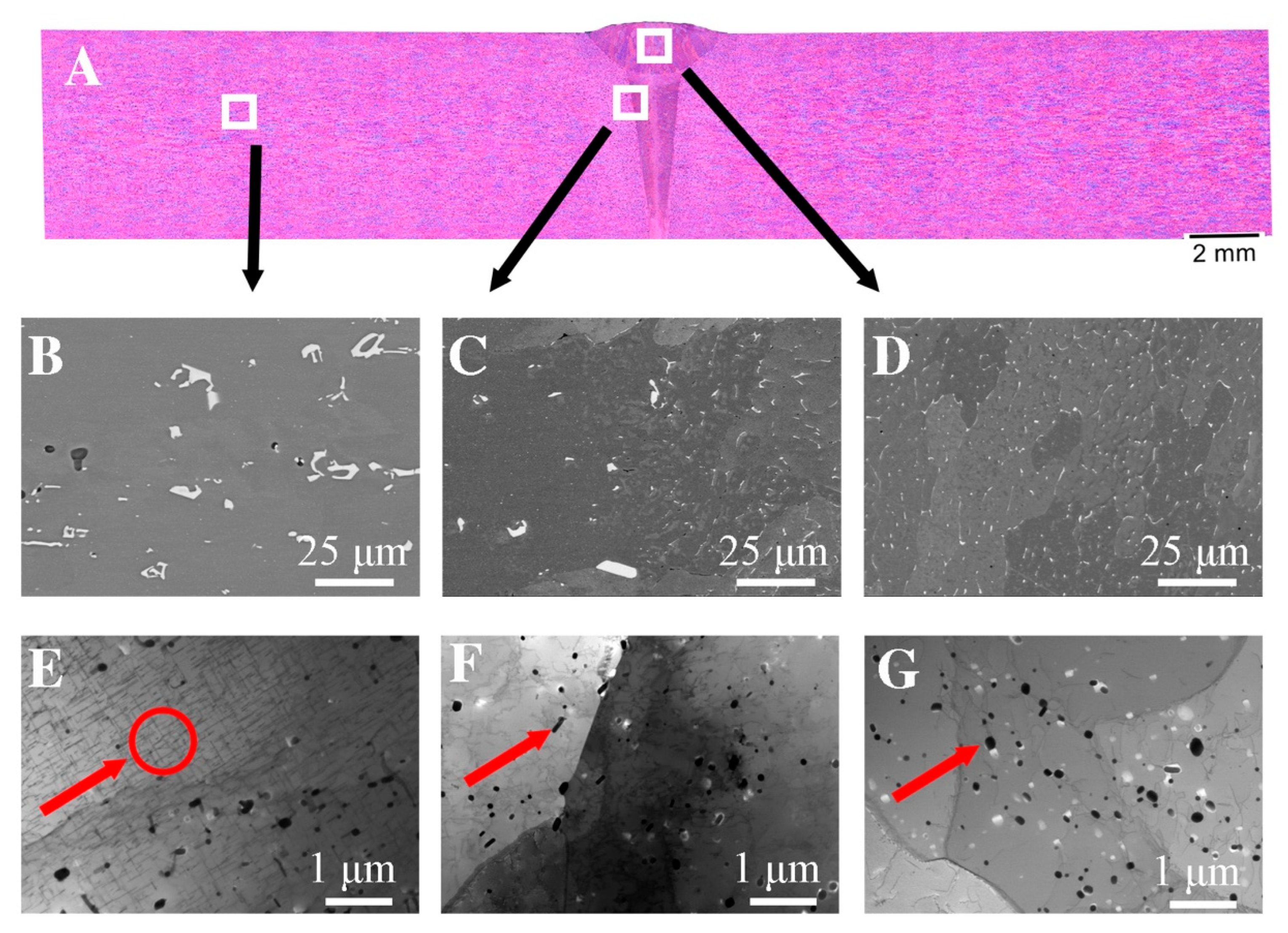

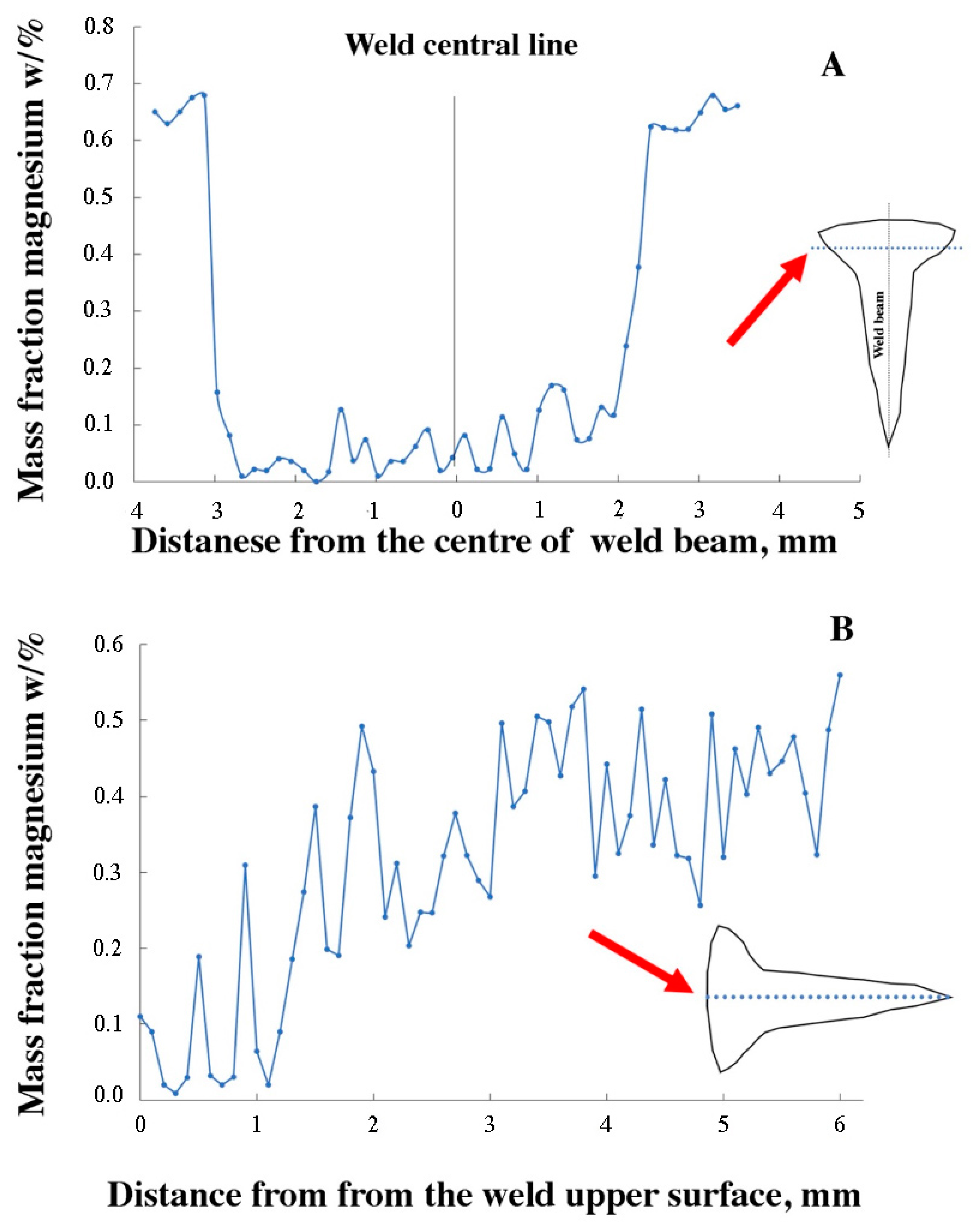
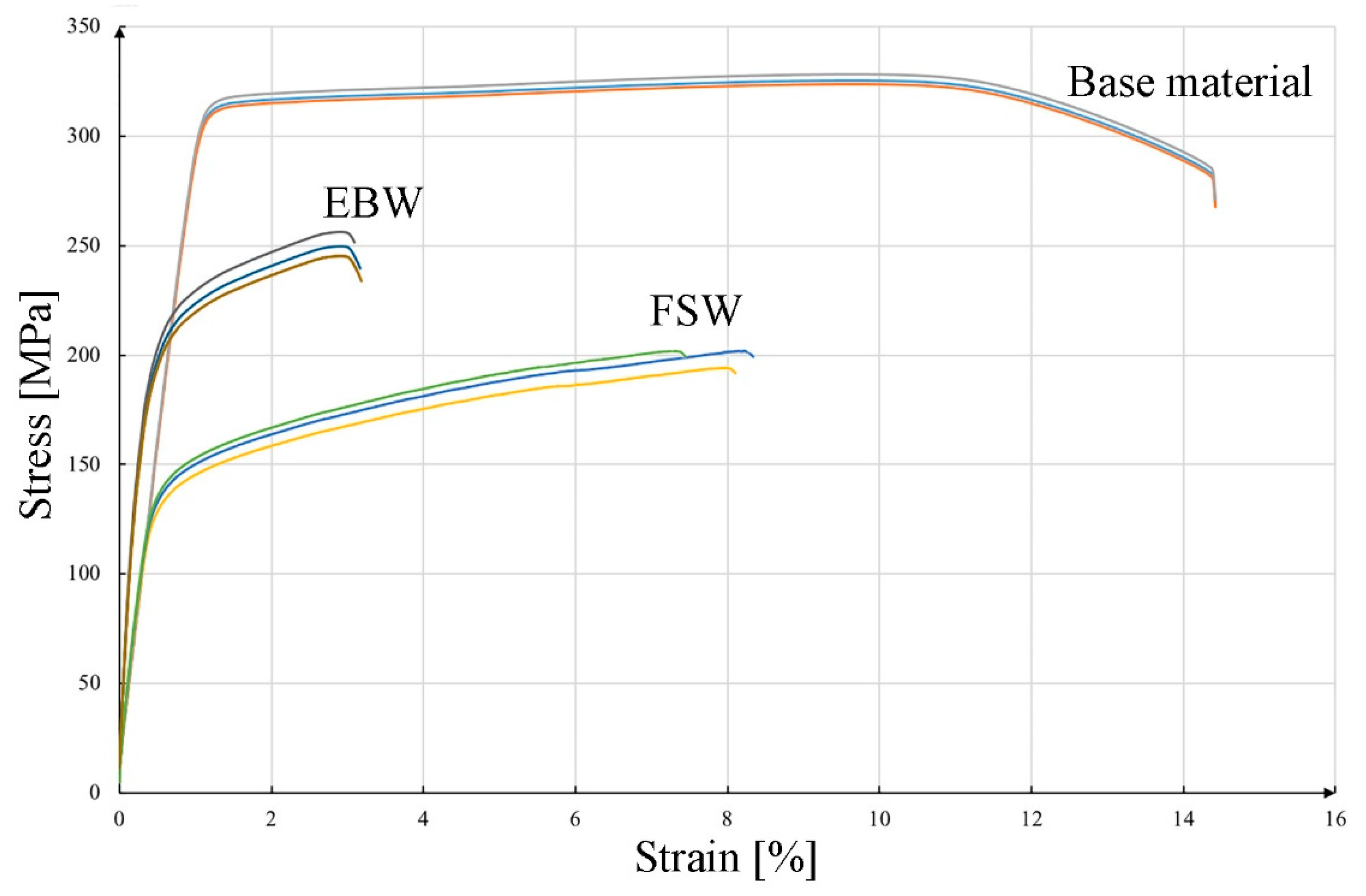

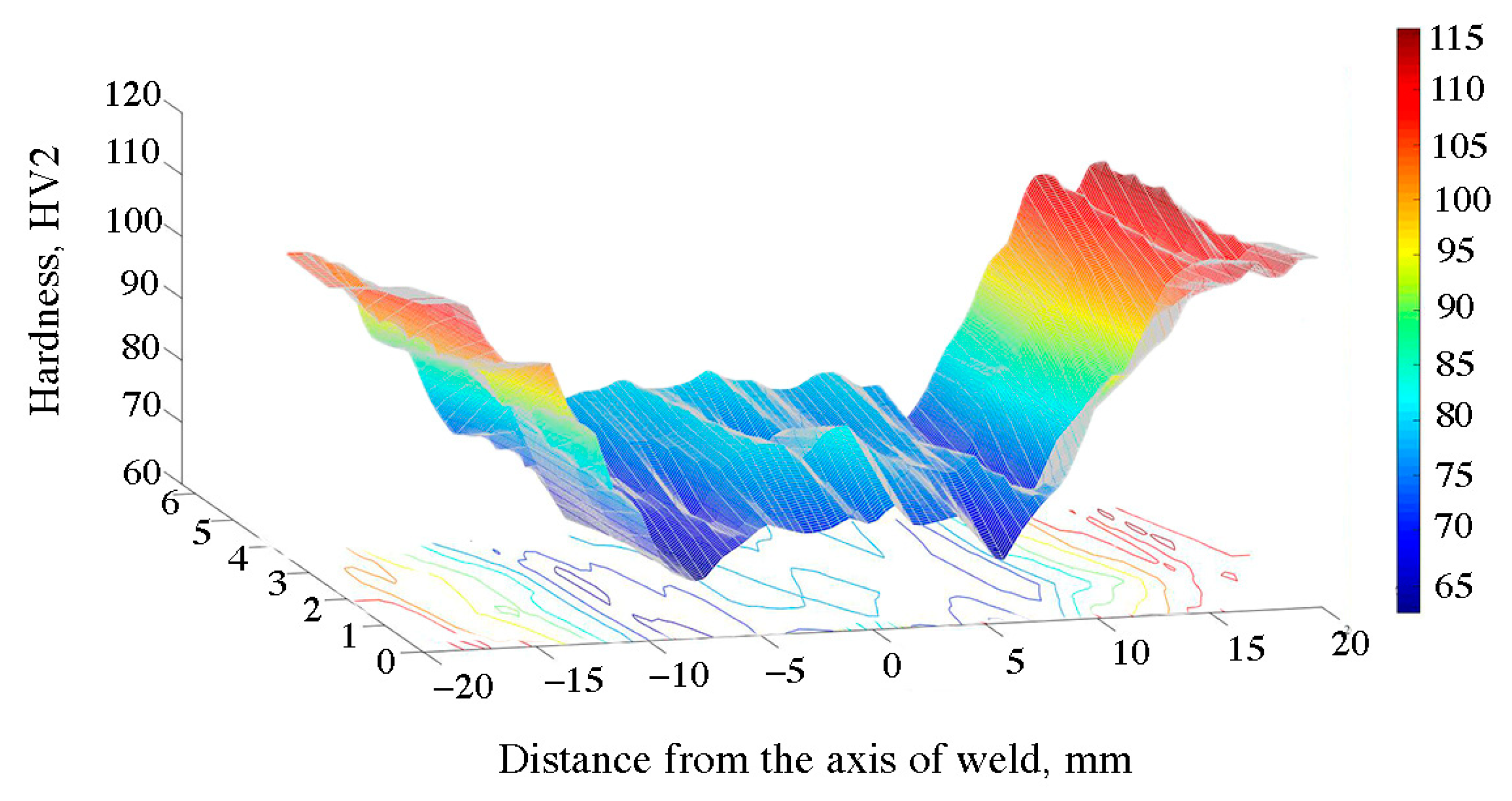

| Element | Al | Si | Fe | Cu | Mn | Mg | Cr | Zn | Ti | Other |
|---|---|---|---|---|---|---|---|---|---|---|
| Required by EN 1706 for base metal | 97.13 | 1.0 | 0.3 | 0.05 | 0.67 | 0.6 | 0.06 | 0.07 | 0.07 | 0.05 |
| Element | UTS, MPa | YS, MPa | Elongation, % | Hardness, HB | Density, g/cm3 |
|---|---|---|---|---|---|
| Required by EN 1706 for base metal | ≥310 | ≥260 | ≥10 | ≥91 | 2.7 |
| Nugget Zone (NZ) | Mg | Al | Si | Mn | Fe |
|---|---|---|---|---|---|
| 1 | 0.0 | 60.7 | 9.9 | 15.6 | 13.8 |
| 2 | 0.0 | 59.0 | 8.4 | 13.8 | 18.8 |
| 3 | 0.0 | 61.6 | 8.7 | 12.4 | 17.3 |
| 4 | 0.5 | 97.9 | 1.1 | 0.2 | 0.3 |
| EBW 6082_Face of Weld | Mg | Al | Si | Mn | Fe |
|---|---|---|---|---|---|
| 1 | 0.0 | 85.0 | 3.6 | 3.1 | 8.3 |
| 2 | 0.0 | 84.3 | 4.9 | 3.8 | 7.0 |
| 3 | 0.0 | 84.9 | 4.0 | 3.6 | 7.5 |
| 4 | 0.0 | 85.8 | 3.9 | 3.0 | 7.3 |
| 5 | 0.4 | 97.8 | 1.2 | 0.3 | 0.3 |
| Base Material | St. Dev. | EBW | St. Dev. | FSW | St. Dev. | |
|---|---|---|---|---|---|---|
| UTS, MPa | 325.00 | 2.17 | 250.00 | 5.42 | 200.00 | 5.05 |
| YS, MPa | 302 | 2.12 | 210 | 3.70 | 140.30 | 3.10 |
| Elongation, % | 13.10 | 0.7 | 2.70 | 1.60 | 7.2 | 1.20 |
| EBW | St. Dev. | FSW | St. Dev. | |
|---|---|---|---|---|
| Base material | 110 | 5.03 | 110 | 5.03 |
| Heat affected zone | 90 | 4.20 | 70 | 4.10 |
| Weld | 72 | 3.60 | 78 | 2.20 |
Disclaimer/Publisher’s Note: The statements, opinions and data contained in all publications are solely those of the individual author(s) and contributor(s) and not of MDPI and/or the editor(s). MDPI and/or the editor(s) disclaim responsibility for any injury to people or property resulting from any ideas, methods, instructions or products referred to in the content. |
© 2023 by the authors. Licensee MDPI, Basel, Switzerland. This article is an open access article distributed under the terms and conditions of the Creative Commons Attribution (CC BY) license (https://creativecommons.org/licenses/by/4.0/).
Share and Cite
Noga, P.; Skrzekut, T.; Wędrychowicz, M.; Węglowski, M.S.; Węglowska, A. Research of Friction Stir Welding (FSW) and Electron Beam Welding (EBW) Process for 6082-T6 Aluminum Alloy. Materials 2023, 16, 4937. https://doi.org/10.3390/ma16144937
Noga P, Skrzekut T, Wędrychowicz M, Węglowski MS, Węglowska A. Research of Friction Stir Welding (FSW) and Electron Beam Welding (EBW) Process for 6082-T6 Aluminum Alloy. Materials. 2023; 16(14):4937. https://doi.org/10.3390/ma16144937
Chicago/Turabian StyleNoga, Piotr, Tomasz Skrzekut, Maciej Wędrychowicz, Marek St. Węglowski, and Aleksandra Węglowska. 2023. "Research of Friction Stir Welding (FSW) and Electron Beam Welding (EBW) Process for 6082-T6 Aluminum Alloy" Materials 16, no. 14: 4937. https://doi.org/10.3390/ma16144937
APA StyleNoga, P., Skrzekut, T., Wędrychowicz, M., Węglowski, M. S., & Węglowska, A. (2023). Research of Friction Stir Welding (FSW) and Electron Beam Welding (EBW) Process for 6082-T6 Aluminum Alloy. Materials, 16(14), 4937. https://doi.org/10.3390/ma16144937







